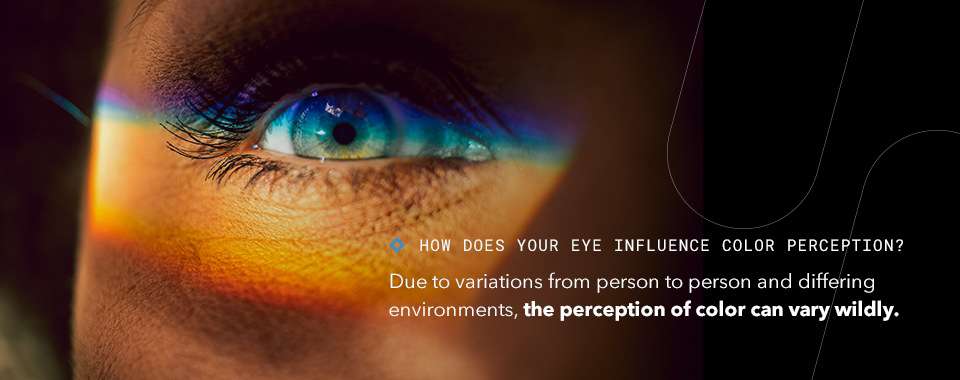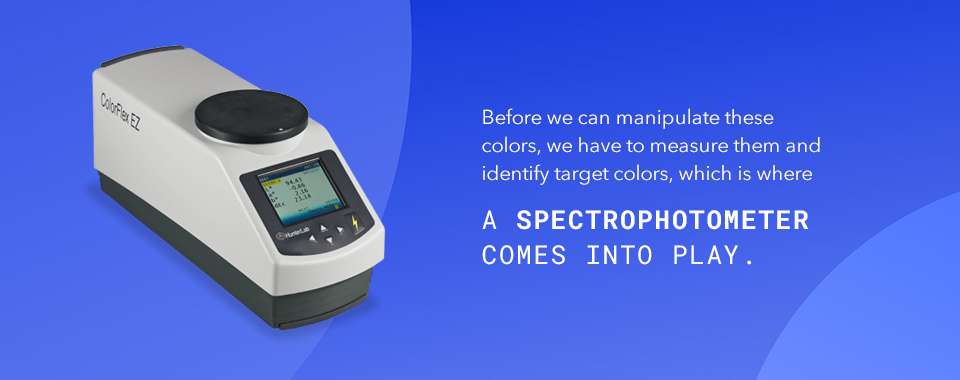Here's how the entire process works.
- Light hits an object.
- Specific lightwaves reflect off some materials and get absorbed by others.
- That reflected light enters the eye, where the lens focuses it toward cones and rods.
- The cones and rods react to the light and encode it into signals the brain can read.
- These signals get sent to the brain through a complex network of neurons and synapses. The brain then perceives those signals as color.
With all these moving parts, an object that reflects specific wavelengths won't always look the same between viewers, so finding unbiased color measurements is essential.
How Cones in Our Eyes Affect Our Vision
Those cones and rods are crucial to making sense of vision and light. Once light hits your eyes, the lens of your eye focuses it onto those light-sensitive cells, rods, and cones, each of which picks up different wavelengths of energy. Rods work best in dim light, while cones specialize in specific ranges of colors.
- L-cones: L-cones, or red cones, make up 64% of our cones and are sensitive to the longer wavelengths that make red light.
- M-cones: Making up 32% of cones in the eye, M-cones, or green cones, respond to medium-wavelength, or green, light.
- S-cones: S-cones are also called blue cones since they pickup shorter wavelengths like blue. They only make up about 2-7% of total cones.
- Rods: Rods work in low light and help us see at night without color reception. They also play into our peripheral vision.
If you're wondering what color humans see best, look at the M-cones. As it turns out, green is right in the middle of the spectrum and is the easiest color to see.
What Is Color Theory?
Color theory combines much of the information about color into a design tool. You're probably familiar with the color wheel, which arranges visible colors by their natural electromagnetic wavelengths. For instance, the color wheel moves from red, the longest, to violet, the shortest.
There are several ways to mix colors, such as additive and subtractive methods, but they usually work with primary, secondary, and tertiary colors. Primary colors are those that can't be created by mixing other colors. They are red, blue and yellow. We don't have a color receptor for yellow, but we do have one for green. So, how do we see yellow?
There's a reason we associate yellow with sunlight and other bright lights. That's because yellow is one of the brightest colors. Detecting yellow requires our brains to combine the excitement levels of red and green cones.
Factors That Influence How We See Color
In addition to intrinsic or taught color perception, numerous additional variables influence color vision:
- Lighting: Light has a significant impact on color perception. The hue of light influences the color that your brain perceives.
- Retinal fatigue: Your eyes can get fatigued quickly. When you gaze at an object for more than a few seconds, chemicals in your eyes decrease and transmit inaccurate signals to your brain.
- Age: As you get older, your ability to see color fades. Fortunately, color vision is not only innate but also an acquired skill.
- Backdrop effects: A phenomenon known as simultaneous contrast occurs when the backdrop against which we assess color impacts our eyes' ability to detect the color correctly.
- Poor color memory: Humans have terrible color memory. It's futile to simply gaze across the room to see if two colors match.
Environmental Influences on Color Evaluation
What are the implications of these environmental difficulties for color analysts and comparisons? You must grasp the effect of light on color perception, be aware that your eyes are easy to deceive, and use the workarounds developed by color science engineers:
- A weary eye cannot make effective color judgments, particularly after being overstimulated by a bright hue. Rest your eyes before observing, examine quickly, and rest again before the next color assessment.
- Always be mindful of your surroundings. Hues can appear different depending on the surrounding colors. When assessing color, utilize a light booth to verify that nothing obscures your vision.
- Determine what sort of light is illuminating your color. A light booth can assist you in managing the illumination and maintaining uniformity.
- To record color information, use color measuring equipment. A colorimeter or spectrophotometer detects reflected light from the desired sample region, and the sample is not influenced by any surrounding colors.
The Mathematics of Color
Subjectivity in color perception poses a significant challenge for businesses, leading to production delays, material waste, and quality control issues. Manufacturers have embraced a mathematical approach to color specification to attain color accuracy and consistency.
The CIE XYZ color space, created in 1931, is the foundation for this technique. It defines colors in a three-dimensional space using red, green, and blue values. Building on this basis, other models, such as CIELAB (1976), included characteristics such as luminance (L), red-green (A), and blue-yellow (B) axes for more complex color representation. Another model, CIE LCh, includes lightness, chroma, and hue to provide even more detailed color descriptors.
Colorimeters and spectrophotometers are specialized equipment used for objective color measurement. These gadgets offer exact digital representations of color, eliminating subjectivity. In essence, mathematics provides an objective language for color, allowing organizations to achieve uniform color replication while minimizing costly mistakes.






